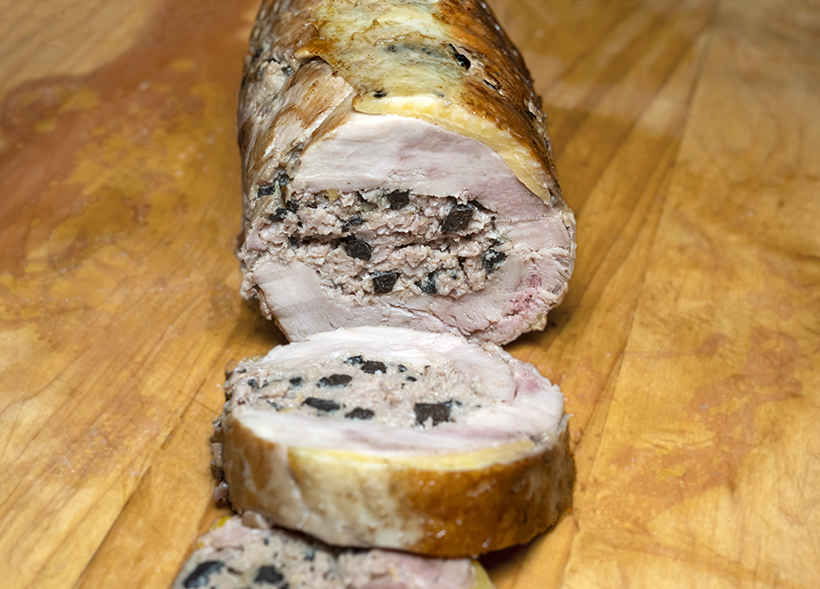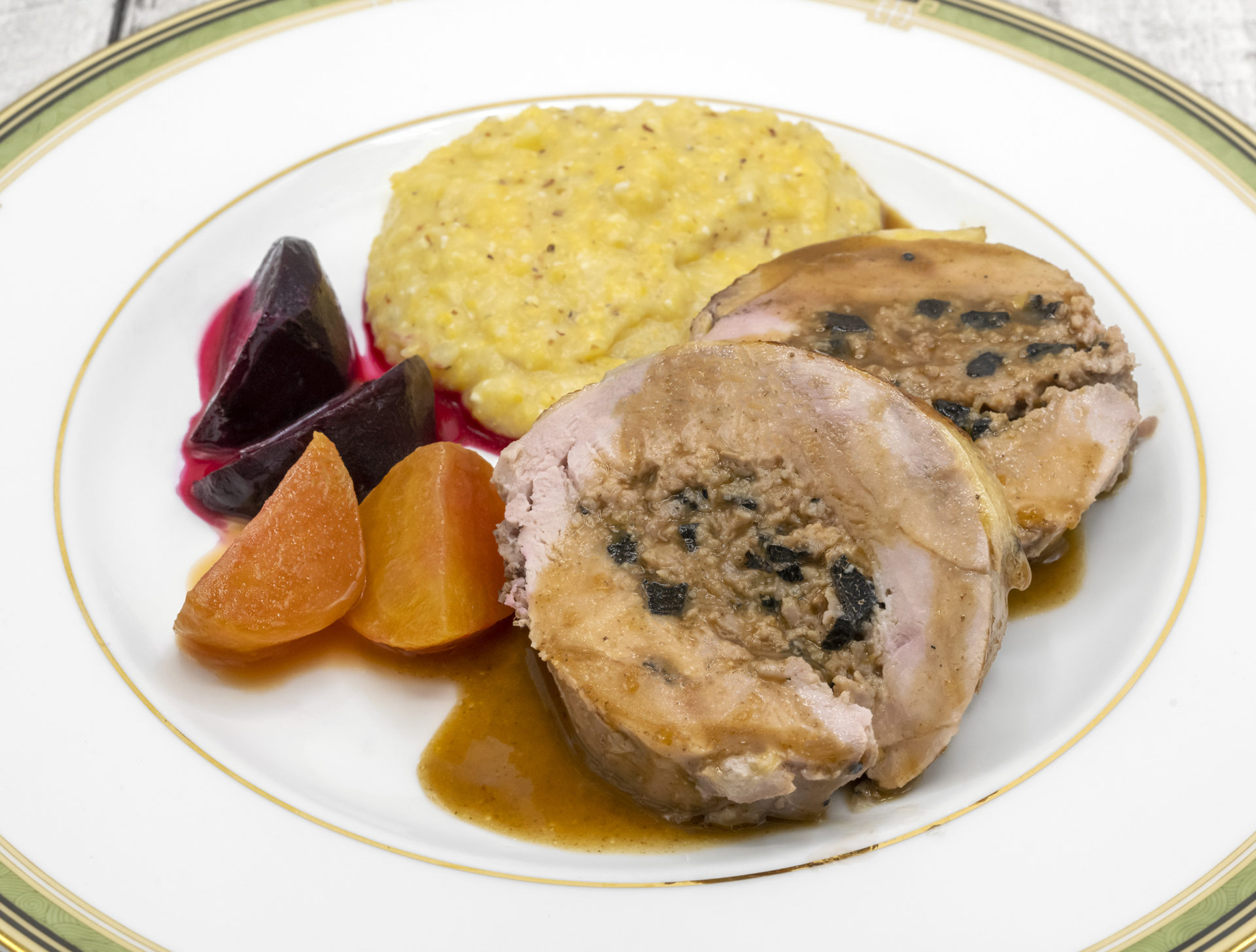Over the years, I’ve published a number of Russian-ish game bird recipes on these pages. First, there was the pheasant à la russe adapted from The Derrydale Game Cookbook. Then I created a stuffed wild pheasant with morel coulis and spring vegetables. And more recently, I went back to the Derrydale for a double feature, the grouse à la moscovite and braised lettuce à la russe. Due to a delivery error that resulted in two “unwanted” wild pheasants sitting in my freezer (thanks, D’artagnan!), I decided to add one more recipe to the collection: Pheasant Galitzin.
Once upon a time, the Galitzin / Golitsyn family (both spellings are widespread) was one of the largest noble houses in the Russian Empire, descending from a 15th-century Lithuanian prince. One of them, Prince Mikhail Ivanovich Bulgark, earned the name “Golitsa” (glove; geležìs in Old Lithuanian) for an iron glove he wore in a battle against the Kingdom of Poland in 1514. His line soon provided Russia with an endless supply of boyars, warlords, diplomats, ambassadors, generals, and chamberlains. Some of them became the richest men of Russia – the Vyazomy Manor, the Arkhangelskoye Palace, and the Dubrovitsy Manor are all their former family estates in the Moscow region. Even memoirists such as Filipp Vigel had trouble keeping track of who’s who: “So numerous are the Golitsyns that soon it will be impossible to mention any of them without the family tree at hand.” But the Bolshevik revolution wasn’t kind to noble houses, and only one branch survived in the Soviet Union, all the others having disappeared during the Russian Civil War, been shot or killed in the Gulag, or forced into exile.






Which Golitsyn gave his name to the dish I’m presenting in this post? I don’t know, as none of the recipes I’ve found bother with any historical context. Maybe it was Dmitri Alekseyevich Gallitzin, Russian diplomat and art agent for Catherine the Great and Russian ambassador in Paris in the second half of the 18th century? Or perhaps Prince Lev Golitsyn, who set up the famous Massandra and Novy Svet wineries in the late 19th century?
What I do know is that Pheasant Galitzin, a pheasant stuffed with ground snipe and copious amounts of cream and butter, appears in Escoffier’s Guide Culinaire as well as in The Derrydale Cookbook. Both recipes are nearly identical except for the following: Escoffier adds a gargantuan amount of black truffle, while Louis Pullig De Gouy, in the Derrydale, yields to the uber-kitsch plating traditions of his time, recommending toast triangles and lemon slices dipped in parsley and paprika.
I’m choosing to stay closer to Escoffier than De Gouy, which means that this is gonna be quite an expensive recipe. However, in a world full of artificial truffle flavor, it will remind you how real black winter truffle truly tastes, and why it’s worth seeking. I am replacing the snipe in the stuffing with wild pheasant, since the only way I know to procure snipes is to hunt them myself and the season is closed. As the literature lacks garnish suggestions, I am serving the bird with roasted beets and polenta, two ingredients that pair well with truffle.
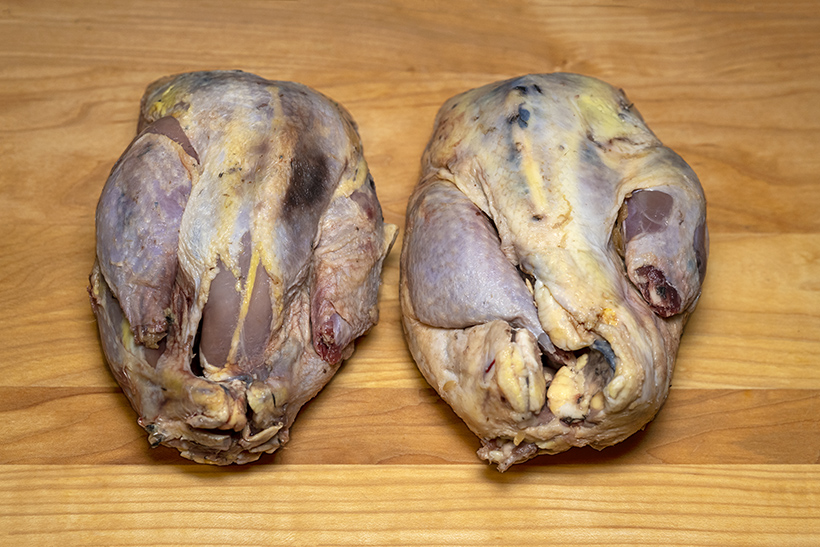
Pheasant Galitzin
Yields 6 servings
Total preparation: 4 hours 45 minutes
Active preparation: 2 hours 30 minutes
Stuffed pheasant
2 wild Scottish pheasants, about 700 g each
60 g butter, softened
60 g crème fraîche
40 g peeled black truffle, small dice
0.2 g black pepper, ground
3.5 g salt
1 g transglutaminase (optional)
8 g water (optional)
- Take the largest pheasant. Cut off the wings and drumsticks, and reserve for the stuffing (together with the liver if you like). Position the bird on its breast, and separate the meat from the carcass, starting from the middle. Once you’re done, the breast and thighs should still be attached together as one (you can watch this video to get a better idea of how it should be done). Remove the thigh bones and any other tiny, thin leg bones. Reserve the carcass and bones for the sauce.
- Cut the smaller pheasant into 8 pieces (2 each of breasts, thighs, legs, and wings). Reserve the thighs, legs, and wings for the stuffing (together with the liver if you like). Keep the breast meat together with the boned pheasant of the previous step. Reserve the carcass and bones for the sauce.
- Pick all the meat off the bones from the parts reserved for the stuffing (2 thighs, 4 drumsticks, and 4 wings), making sure to remove all the tiny leg bones, keeping the skin, and optionally adding the livers. You should have 190 g of boneless meat / skin / liver. If you have less, add some of the breast meat from the smaller pheasant. If on the contrary, you have more, remove some of the thigh meat and reserve it with the boned pheasant.
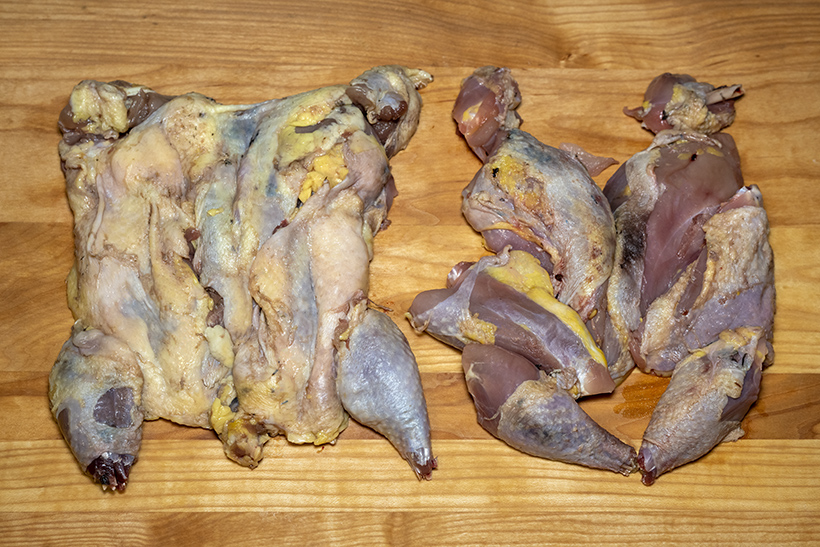
- Grind the above 190 g of boneless pheasant using the large (8 mm) die, then the small (4 mm) die of a meat grinder. After each grinding, scrape all the meat from the inside of the grinder (feeding tube and auger) – this meat is too precious to be wasted! You should end up with about 180 g of ground meat. Combine in a bowl with the butter, crème fraîche, black truffle, black pepper, and about 4/5 of the salt. Refrigerate for at least 1 hour.
- Arrange the boned pheasant skin-side down on a sheet of plastic film. Use the breast meat from the smaller pheasant in order to fill in gaps and form a rectangle of about 23 cm x 19 cm, of even thickness (see photo below). You can pound the meat lightly to obtain a more regular rectangle. Optionally, mix the transglutaminase with the water in a small bowl, then brush all over the meat. Season with the remaining salt.
- Shape the stuffing into a cylinder about 21 cm long, and arrange it lengthwise on the pheasant rectangle. Wrap the meat around the stuffing, and tightly wrap it all in several layers of plastic film (the first layer is usually pretty loose, the next gets tighter). Place the plastic-wrapped stuffed pheasant into a sous-vide pouch, and vacuum-seal. Refrigerate for at least 2 hours. The stuffed pheasant can be kept in the refrigerator for one day.
- Cook the stuffed pheasant, in the sous-vide pouch, in a 60 C / 140 F water bath for 3 hours, then reserve in the water bath until ready to serve.

Roasted beets
about 300 g baby golden beets
about 300 g baby red beets
300 g veal stock
40 g butter, diced
- Without peeling them, season the golden and red beets with salt, and wrap them individually in foil. Place on a baking dish, and cook in a 175 C / 350 F oven for about 1 hour, to an internal temperature of 95 C / 200 F. Let cool for a few minutes.
- Take the beets out of the foil, and peel. Cut them into wedges to obtain 12 pieces of each kind.
- In a small saucepan over high heat, reduce the veal stock to 40 g. Lower the heat and whisk in the butter. Reserve.
- Place the golden and red beets in sous-vide pouches separately, each kind with half of the reduced stock. Vacuum seal, and reserve. The beets can be kept in the refrigerator for one day.
Pheasant sauce
10 g canola oil
About 400 g pheasant carcasses and bones
salt
100 g red wine
500 g veal stock
6 g black truffle peelings
60 g butter, diced
- Heat the oil in the pot of a pressure cooker over high heat, and sauté the carcasses and bones seasoned with salt until brown. Add the red wine and reduce by half. Add the veal stock and truffle peelings, then cover, bring to pressure, and cook under pressure for 30 minutes. Let cool for 10 minutes.
- Open the pressure cooker and pass the sauce through a chinois. Transfer to a small saucepan, then reduce to 80 g over medium-high heat. Lower the heat and whisk in the butter. Reserve.
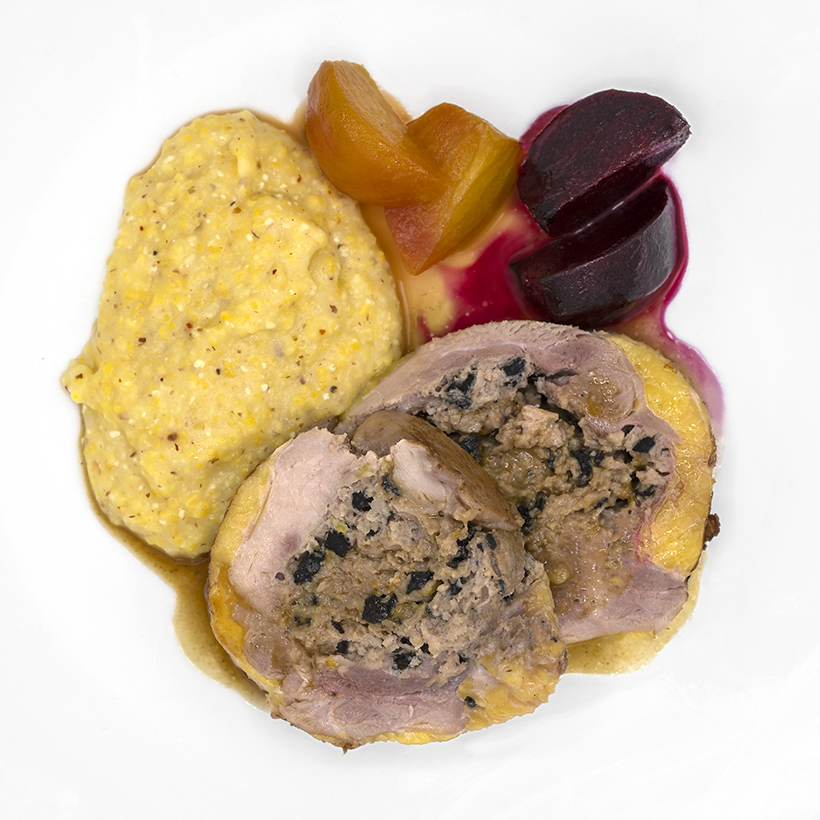
Polenta
135 g coarse cornmeal
675 g water
4.2 g salt
0.5 g piment d’espelette
30 g butter
25 g parmesan, finely grated
- Place the cornmeal and water in a saucepan, and bring to a simmer over medium-high heat, stirring constantly, until the first starch takes hold, 5-8 minutes.
- Reduce the heat to low and cook, stirring frequently, until the grains are soft and hold their shape on a spoon, about 1 hour.
- Keep warm and proceed to assembly immediately. Before serving, mix in the salt, piment d’espelette, butter, and parmesan. If necessary, thin the polenta with a little bit of hot water.
Assembly
roasted beets
stuffed pheasant
salt
pheasant sauce
1 g lemon zest, grated with a Microplane
5 g butter
10 g canola oil
polenta
- Add the beets to the water bath with the pheasant (60 C / 140 F), and warm for at least 15 minutes.
- Take the stuffed pheasant out of the sous-vide pouch and plastic wrap, and season generously with salt. Mix the cooking juices with the pheasant sauce, add the lemon zest, and keep warm in a small saucepan.
- Melt the butter with the canola oil in a pan over medium heat. Add the stuffed pheasant, and sauté, turning until brown on all sides. Remove from the heat and let rest for a minute.
- Cut the meat into 12 slices, excluding the ends. On each plate, place a few spoonfuls of polenta next to a couple of beet wedges of each color, basted with some of their cooking liquid; rest two slices of pheasant against the polenta, and coat with the sauce. Enjoy!
